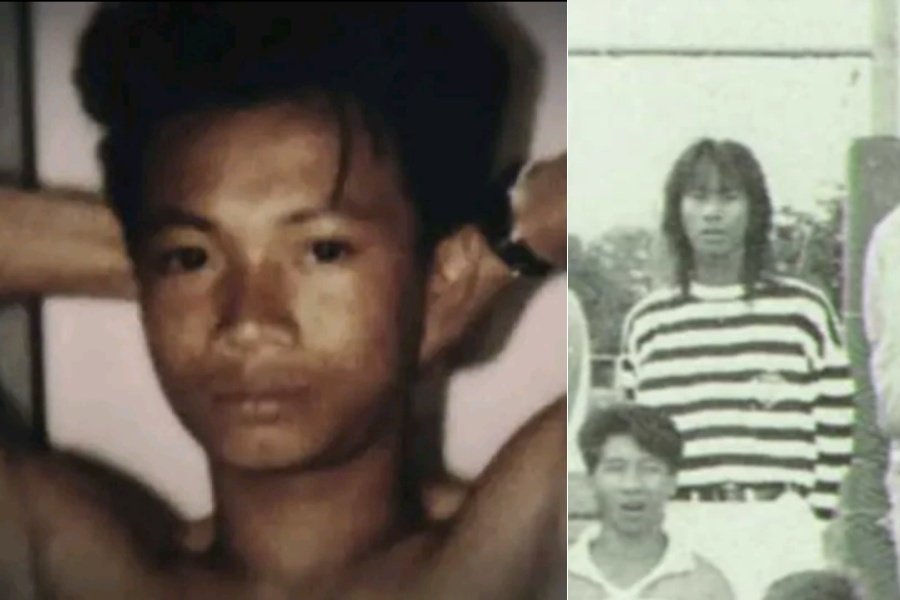Can a single act of negligence erase a life, and in doing so, expose a systemic failure within the very institutions designed to protect its citizens? The tragic story of Konerak Sinthasomphone, a young boy whose encounter with Jeffrey Dahmer would forever be etched in infamy, is a stark reminder of this devastating reality.
The harrowing events unfolded in Milwaukee, Wisconsin, a city grappling with the shadows of a notorious serial killer in the summer of 1991. Konerak Sinthasomphone, a young boy whose life was tragically cut short when he crossed paths with the notorious Jeffrey Dahmer. To understand the depth of this tragedy, it is crucial to delve into the circumstances that led to this devastating outcome. In 1979, a toddler named Konerak Sinthasomphone, along with his family, embarked on a journey from Laos, seeking refuge and the promise of a brighter future in America. They settled in Milwaukee, Wisconsin, joining the citys vibrant Laotian community. Eight children, along with their parents, shared a single roof, building a life together.
On May 26, 1991, the paths of Konerak and Jeffrey Dahmer crossed. Dahmer, preying on the vulnerability of his victims, met Konerak walking down Wisconsin Avenue. Dahmer quickly perceived Koneraks innocence and realized he could easily be manipulated. He lured the young boy to his apartment, offering him money in exchange for photographs, a sinister proposition that ultimately sealed Konerak's fate. On May 27, 1991, the nightmare reached its peak. Dahmers neighbor, Glenda Cleveland, along with her daughter Sandra Smith, and her niece, Nicole Childress, alerted authorities to a disoriented, bleeding boy. This boy was later identified as Konerak, but it was too late.
| Bio Data | Details |
|---|---|
| Full Name | Konerak Sinthasomphone |
| Born | Approximately 1982 (estimated) in Laos |
| Died | May 27, 1991 (age approximately 9) in Milwaukee, Wisconsin |
| Cause of Death | Murdered by Jeffrey Dahmer |
| Known For | Victim of Jeffrey Dahmer, whose case highlighted failures in the Milwaukee Police Department. |
| Family | Parents and seven siblings (lived in Milwaukee's Laotian community) |
| Residence | Milwaukee, Wisconsin |
| Date of Arrival in USA | 1979 |
Reference: Wikipedia
The grim details of that day are deeply disturbing. The heavily drugged Konerak managed to escape Dahmers apartment, desperately seeking help from neighbors. His condition was critical, and he was incoherent, blood staining his rectum. He was in dire need of medical attention. Despite the obvious signs of distress, the police, upon arrival, failed to recognize the gravity of the situation. Instead, they dismissed the pleas of the concerned neighbors, infamously returning the boy to Dahmer's apartment. Only half an hour after the authorities left, Dahmer murdered Konerak. Konerak was brutally murdered on May 27, 1991, by Jeffrey Dahmer, a serial killer and repeat sex offender. His body was dismembered, along with those of other victims, and found within Dahmers apartment.
The ramifications of this failure were immense. The officers involved were suspended, albeit with pay, a decision that further fueled public outrage. While Konerak's parents received some financial compensation, it was a meager gesture that could never compensate for the irreplaceable loss of their child. No amount of punishment, whether given to the officers or Dahmer himself, could undo the tragic events. The news of his horrifying death sent shockwaves through the neighborhood, leaving residents feeling vulnerable, frightened, and heartbroken. It brought to light serious failures within the Milwaukee Police Department and the justice system. These failures ultimately enabled Dahmer to continue his killing spree. Jeffrey Dahmer, the infamous Milwaukee Monster, was on probation for sexual molestation when he killed Konerak Sinthasomphone, which reportedly could have been prevented.
The tragedy surrounding Konerak Sinthasomphone highlights the vulnerability of the most innocent among us and the devastating consequences of systemic failures. The case sparked outrage and a painful reckoning within the community. It exposed the deep-seated biases and prejudices that can blind those in positions of authority, leading to devastating outcomes. To understand the magnitude of the loss, we must go back to Laos in the 1970s, where Konerak's journey began. The family's flight from their homeland and subsequent settlement in the Laotian community of Milwaukee underscore the dreams, hopes, and struggles of refugees searching for a better life. The story of Konerak is a testament to the importance of empathy, compassion, and vigilance in protecting the vulnerable. It is a reminder that every life holds value and deserves to be safeguarded.
The investigation and the aftermath revealed a series of missed opportunities and critical errors made by law enforcement. The officers who responded to the initial call dismissed the pleas of concerned neighbors who understood the danger Konerak was in. They failed to recognize the clear signs of duress and the potential threat. Instead, they made a catastrophic decision that would cost Konerak his life. This tragic incident exposed the failures of the Milwaukee Police Department. The response to the situation was inadequate, failing to protect a vulnerable child and allowing a serial killer to continue his heinous acts. The investigation that followed revealed a pattern of negligence and disregard that allowed Dahmer to evade scrutiny and continue his crimes.
The case of Konerak Sinthasomphone is not just a story of a single tragedy but a reflection of broader societal issues, including the impact of prejudice and the importance of holding institutions accountable. The Laotian community in Milwaukee was deeply affected by this tragedy. The loss of Konerak amplified existing fears and vulnerabilities within the community, and it served as a painful reminder of the challenges faced by immigrant communities. Dahmer had, in fact, previously assaulted Konerak's brother, Somsack, in 1988, further underlining the pattern of his predatory behavior. The failure of the authorities to intervene that day demonstrated how the most vulnerable members of society can be let down by the very people and institutions meant to protect them.
The case brought into focus the need for improved training and sensitivity within law enforcement, as well as the need to address the prejudices that can cloud judgment and impede the proper execution of duty. It also spurred discussions about the importance of community involvement and the crucial role that neighbors and concerned citizens play in protecting vulnerable individuals. The story serves as a reminder of the value of vigilance and the importance of speaking out when something doesn't seem right. The media coverage of the case, which was extensive and often graphic, brought the story of Konerak Sinthasomphone to a global audience, sparking outrage and fueling demands for reform.
The aftermath of the tragedy brought some measure of justice, but it could never erase the pain. The officers involved were suspended, but their actions had already sealed Konerak's fate. Dahmer was eventually apprehended and convicted of multiple counts of murder. However, the fact remains that Konerak's death could have been prevented. The failure to recognize the gravity of the situation and the subsequent inaction created a ripple effect of pain and suffering that continues to resonate today. Konerak Sinthasomphone's story continues to serve as a cautionary tale. His memory is a call to action, reminding us of the importance of compassion, vigilance, and accountability in society.
The response from Dahmers neighbors, Glenda Cleveland, Sandra Smith, and Nicole Childress, stands in stark contrast to the failings of the authorities. Their immediate concern for Koneraks well-being and their persistence in seeking help highlight the importance of community and the power of individual action. Their efforts, though ultimately unsuccessful in saving Konerak, underscore the moral imperative to act when witnessing injustice. The incident revealed a number of failures within the Milwaukee Police Department. The police failed to adequately assess the situation, listen to the concerns of the neighbors, and respond with the urgency that the situation demanded. These failures allowed Dahmer to continue his heinous acts, resulting in the tragic loss of Koneraks life.
The brutality of Dahmer's crimes, including the dismemberment of his victims' bodies, was particularly shocking. The discovery of Konerak's body, alongside the bodies of other victims, brought the full horror of Dahmer's actions to light. This gruesome reality forced the community to confront the dark underbelly of society and the depths of human depravity. The case had a lasting impact on the city of Milwaukee, leading to increased scrutiny of the police department and calls for reforms. The events that unfolded shook the community to its core. Residents felt vulnerable, frightened, and heartbroken. The neighborhood was left reeling from the shock and grief of losing a child. The case also highlighted the importance of mental health awareness and the need for a better understanding of the factors that contribute to violent behavior. The case prompted discussions about the effectiveness of the criminal justice system and the need for better rehabilitation programs.
The details of Dahmer's crimes and the investigation that followed sent shockwaves through the public. The revelations about his methods, his motivations, and the extent of his depravity were deeply disturbing. The public was forced to confront the existence of evil and the capacity for human beings to inflict unimaginable suffering. Dahmers ability to evade detection for so long, despite his repeated offenses, raised serious questions about the efficacy of law enforcement and the criminal justice system. The case continues to be a source of fascination and debate, and it has been the subject of numerous books, documentaries, and films. The tragic story of Konerak Sinthasomphone serves as a reminder of the importance of vigilance, empathy, and justice.
The case also exposed the failures of the social safety net in Milwaukee, highlighting the gaps in support for vulnerable individuals and families. Dahmer's victims were often marginalized individuals, including young men of color and members of the LGBTQ+ community. The case prompted discussions about the need for greater social services and support networks for those at risk. The tragic death of Konerak Sinthasomphone is a reminder of the profound loss of innocent life and the devastating consequences of indifference. Dahmers case serves as a cautionary tale and a reminder of the need to protect the vulnerable.
The legal proceedings against Dahmer brought some measure of closure to the victims families and the community, but they could not undo the damage that had been done. The trial exposed the full extent of Dahmer's crimes, providing a harrowing account of the suffering he inflicted on his victims. The proceedings also highlighted the failures of the police and the justice system. The story of Konerak Sinthasomphone continues to serve as a stark reminder of the price of indifference, the importance of compassion, and the need for constant vigilance in the face of evil. The case sparked a national conversation about the importance of protecting vulnerable individuals and holding those in positions of authority accountable for their actions. The name Konerak Sinthasomphone is etched in infamy. It serves as a symbol of the tragedies that can result from prejudice, negligence, and institutional failure. His memory challenges us to create a society where all lives are valued and protected.


